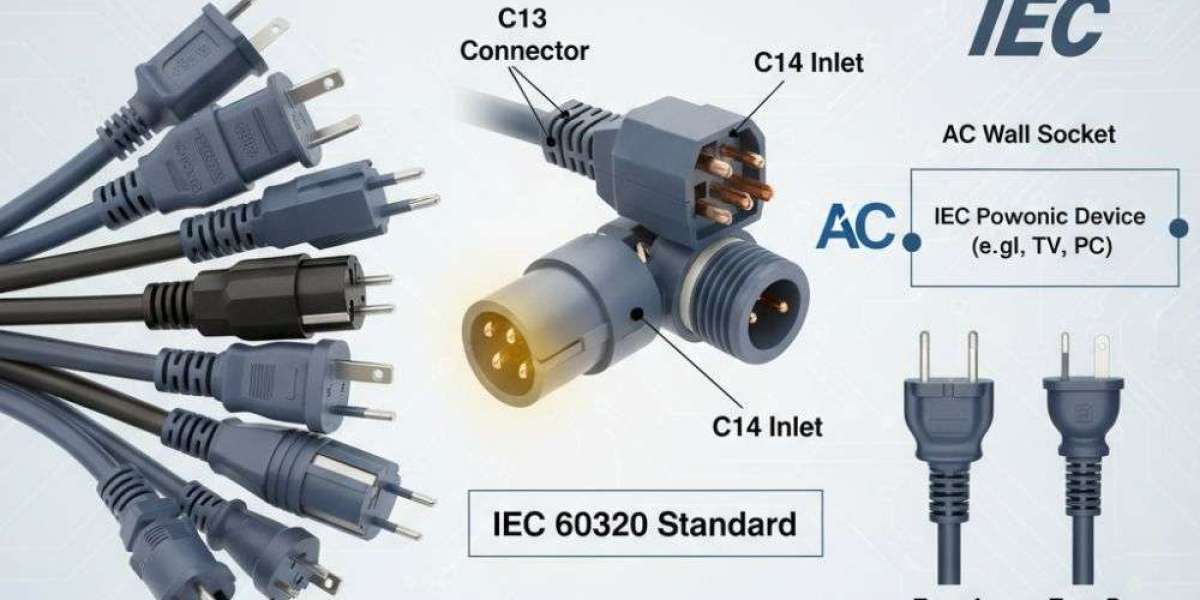If you've ever looked at the back of your computer, monitor, or printer, you've probably noticed a specific type of power connector. That's most likely an IEC power cord. But here's a question many people ask: are these cords truly universal? Can you use the same cable for different devices and in different countries?
Let's break down everything you need to know about IEC power cords and whether they're as universal as you might think.
What Are IEC Power Cords?
IEC stands for International Electrotechnical Commission. This organization creates standards for electrical components used around the world. An IEC cord follows these international standards, which means manufacturers everywhere use the same designs.
You'll find these cords on countless devices. Desktop computers, monitors, printers, servers, projectors, and many other electronics use IEC connectors. The most common type you'll see is the C13/C14 connection, but there are actually several different types in the IEC family.
Understanding the IEC C13 Power Cord
The IEC C13 power cord is the most popular version you'll encounter. If you look at your computer's power cable, there's a good chance it uses this connector. The C13 is the female connector that plugs into your device, while the C14 is the male inlet on the equipment itself.
This particular cord has three pins arranged in a specific pattern. It can handle up to 250 volts and 10 amps in most configurations. That's enough power for most office equipment and home electronics.
Are They Universal? The Simple Answer
Here's where things get interesting. IEC power cords are "universal" in some ways but not in others. Let me explain what that means.
Universal in Design: Yes, the connector end that plugs into your device is standardized worldwide. A C13 connector from the United States will fit perfectly into a device in Europe, Asia, or anywhere else. The device side is truly universal.
Not Universal for Wall Outlets: The other end of the cord - the part that goes into your wall socket - is definitely not universal. Different countries use different plug types. The plug that works in an American outlet won't fit in a British or European socket.
Why the Confusion Exists
People often think IEC cords are completely universal because the device-side connector stays the same everywhere. You can buy a laptop in Japan, bring it to Brazil, and the power connector will still be the same. That part hasn't changed.
However, you'll need a different power cord with the right plug for your local wall outlet. This is actually a smart design. Instead of rebuilding devices for every country, manufacturers just change the power cord.
The Benefits of This System
This standardized approach offers several advantages:
Easy Replacement: When your power cord gets damaged, you can easily find a replacement. You don't need to hunt down a special cable made only for your specific device brand.
Travel Flexibility: When you travel internationally, you only need to swap the power cord. Your device itself doesn't need any modification. This makes international travel much simpler for business and personal trips.
Cost Savings: Manufacturers save money by using standard connectors. They don't need to create unique power solutions for each product. These savings often get passed along to consumers.
Reduced E-Waste: Since multiple devices use the same cord type, you can reuse cables between different equipment. This reduces electronic waste and helps the environment.
Different IEC Cord Types
While the C13 is most common, the IEC family includes many other connector types. Each serves different purposes:
- C5 (Mickey Mouse): Used for laptops and smaller devices
- C7 (Figure-8): Common in radios and small electronics
- C13/C14: The standard for computers and monitors
- C15/C16: Hot condition connectors for electric kettles
- C19/C20: Heavy-duty connectors for servers and high-power equipment
Each type has specific voltage and amperage ratings. Using the wrong type could damage your equipment or create safety hazards.
Voltage Considerations
Even with the right connector, you need to consider voltage differences. Most modern electronics have power supplies that work with 100-240 volts. This covers the voltage ranges used in virtually every country.
However, always check your device's power rating before plugging it in. Some older equipment only works with specific voltages. Using 220 volts on a device designed for 110 volts can cause serious damage.
Finding the Right IEC Cord for Your Needs
When you need a replacement or additional power cord, consider these factors:
Length: Cords come in various lengths. Measure your space to ensure you get adequate reach without excess cable cluttering your area.
Gauge: Thicker cables (lower gauge numbers) carry more current safely. For high-power devices, choose appropriately rated cords.
Certification: Look for cords with proper safety certifications like UL, CE, or CSA. These ensure the cable meets safety standards.
Quality: Not all cables are equal. Better materials and construction provide longer life and safer operation.
Common Misconceptions
Let's clear up some myths about IEC power cords:
Myth 1: All IEC cords are identical. Reality: Different types serve different purposes with varying power ratings.
Myth 2: Any IEC cord works with any device. Reality: While connectors might fit, voltage and amperage ratings must match your device's requirements.
Myth 3: Expensive cords always perform better. Reality: Quality matters, but you don't always need premium cables for basic applications.
Practical Tips for Using IEC Cords
Here are some helpful suggestions for working with these cables:
Keep spare cords on hand, especially if you have multiple devices using the same connector type. This saves time when you need a replacement.
Label your cords when you have many devices in one area. This simple step makes maintenance and troubleshooting much easier.
Inspect cords regularly for damage. Frayed wires, bent prongs, or loose connections create safety hazards. Replace damaged cords immediately.
Don't force connectors. If a plug doesn't fit easily, you might have the wrong type. Forcing connections can damage both the cord and your device.
The Bottom Line
So, are IEC power cords universal? The answer is both yes and no. The device-side connectors are universal and standardized worldwide. This standardization makes life easier for everyone who uses electronic equipment.
However, the wall plug side varies by country and region. You'll need the appropriate plug type for your location's electrical outlets.
This hybrid approach gives us the best of both worlds. We get the convenience of standardized device connections with the flexibility to accommodate different electrical systems worldwide.
Understanding this system helps you make smart decisions when buying replacement cords, traveling with electronics, or setting up new equipment. With the right knowledge, managing your power cords becomes simple and straightforward.
Sources: https://worldscapeinfo.com/everything-you-need-to-know-about-iec-power-cords-and-their-applications/
https://www.storeboard.com/blogs/electronics/what-does-iec-stand-for/6354354



